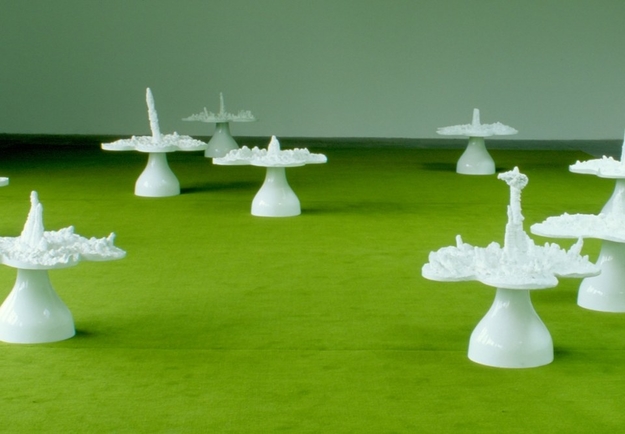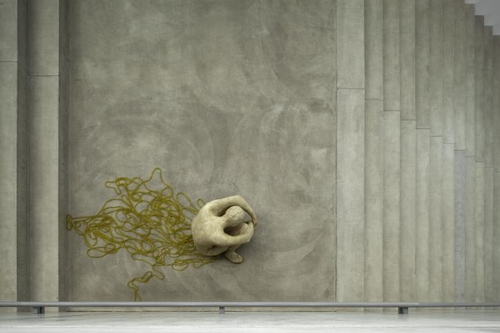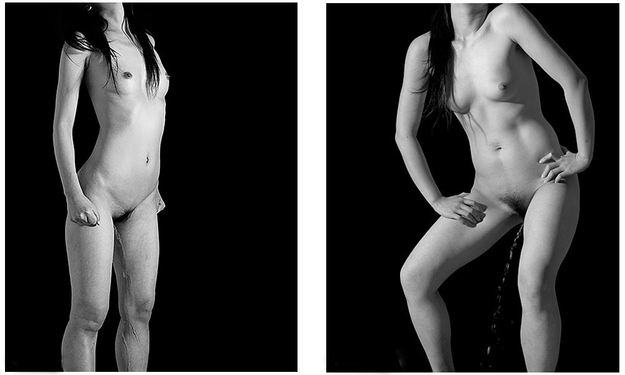"Piss Flowers", Helen Chadwick, 1991-2
The female body was a largely reoccurring theme throughout Chadwick's career. In one of her most notorious installations, Piss Flowers, her and her male partner, David Notaries, urinated in the snow creating "piss holes". A cast of these hollowed impressions resulted in set of 12 shiny white enabled bronzes resembling flowers. The pieces communicate a fluidity of gender in its inverted formation: Chadwick's urine flow is responsible for the sculpture's phallic-shaped stem, while inversely the flowery petals are formed by Notaries' stream. While the use of genitalia as symbols for gender may seem a bit obvious and obsolete, it relates back to the artist's personal experience. Chadwick has referred to the process behind these pieces as a "metaphysical conceit for the union of two people expressing themselves bodily." Not only creating a sensual bond between her and her partner, the work also alludes to the relationship with one's own body — where urine is seen as an extension of the body— and with the body's relationship with the natural world — in that the body unbounds to synthesize with the Earth.
"Pee Body", Kiki Smith, 1992
Kiki Smith’s 1992 piece Pee Body, may not involve any actual urine but it certainly speaks volumes on the subjects of visibility and leakages when it comes to female urination. The life size wax sculpture depicts a female squatting down on the floor as a strings of glistening golden glass beads stream behind her. As one approaches this piece, they are involuntarily exposed to a scene that would normally have it’s audience apologetically turning their head. Instead, one is compelled to face the women on the floor, squatting in a pool of her own piss as her head hangs low in a gesture of humiliation. Here, we quickly recognize the great lengths this woman— and all women— go to in order to conceal and control their bodily fluids. This heavy aura of shamefulness, especially when considering the suggested incontinence, directly reflects on society's habit of body shaming that is directly responsible for female remorse concerning the completely natural occurrences of the female body.
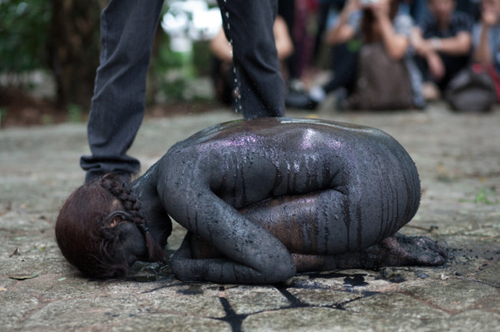
"Piedra", Regina José Galindo, 2013
In a 2013 performance entitled Piedra, artist Regina José Galindo walked into an audience and positioned her body, completely covered with black coal, in a petrified fetal position on the ground. Every 10 minutes, a male-bodied "audience member" would approach Galindo, unbutton their pants and proceed to pee on her as she remained deathly still. The obvious nonchalant attitude and ease in which these male-bodied actors could defile the artist's body parallels the wide-spread apathy regarding the safety and care of women’s bodies. The public aspect of the performance only "further underscores the myopic nature of everyday actions that propel repetitive structural violence." In presenting her body as an insignificant piedra (Spanish for stone) Galindo suggests a quality of disposability. She equates the female body to a stone in their vulnerability to violent enactments. More specifically, her work comments on the violence that is particularly prevalent in Galindo’s homeland of Guatemala and addresses the exploitation of the female workers of Brazil’s colossal coal mining industry. The piece, simple yet highly theoretical, aims to expose a history of violence, especially towards Latin American women, far beyond a local level.
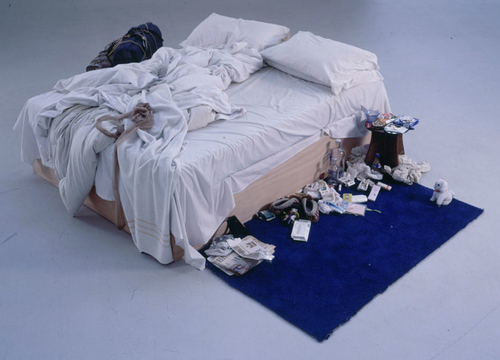
"My Bed", Tracey Emin, 1999
Urine stained sheets may not be the first thing you notice within the piece. In fact, it's presence in My Bed, a piece displaying Tracey Emin's actual bed at the time, may not even be intentional — rather a consequence of her state during a period of an all consuming suicidal depression. The urine, a physical display of incontinence, lends a visual representation to the mental despondency and bodily neglect prompted by her depression. The lack of restraint over one’s bladder mirrors the inability to control one’s own life. It is in her decision to display this grim reality, that Emin puts this typically censored depiction of the female condition under limelight. This extremely intimate glimpse into the hidden side of womanhood is even further bared by it's deglamorized depiction of women's sexuality, forcing the male gaze to remove it's sexualizing and chastening lenses in regard to female behavior.
"Standing Up Peeing" , Jia Chang, 2006
As the name suggests, Standing Up Peeing is a series of photographs depicting nude bodies peeing while standing up. In six photos, Chang depicts models performing the very banal, humanly function of urination in gracefully awkward postures. While the pretext of anatomy has labeled these poses "masculine", the depiction of female bodies mimicking them suggests a brute objection to the social constructs that equate them as "male" in the first place. Here, the female body is celebrated rather than shamed, praised for versatility rather than discredited for its "otherness". The viewer is involuntarily made voyeur as they gaze directly into the artist's invitation to criticize the social structures and taboos that aim to hide and exclude within our modern society.
